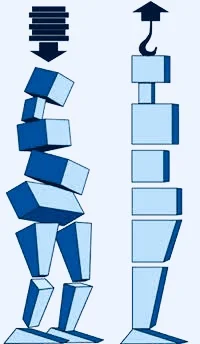Gravity tends to distort our body’s relationship to vertical. The organizing principle of a vertical ‘line’ begins with the observation that much of the difficulty we experience in life is related to this ‘dialogue’ with gravity.
Ida P. Rolf envisioned the ‘Line’ as a dynamic, vertical axis about which the body might be organized. She described it as “ ... parallel to the pull of gravity, and believed the function of the body was optimal when it was organized in that way.“
This ‘Line’ can be envisioned as dropping from the crown of the head through the core of the body until touching the ground between the right and left feet. Observation of where the line falls - closer to one foot or the other - provides insight into structural misalignment. The ‘Line’ is a place to begin, a point of reference when evaluating structural balance.
A critical aspect of this reference is that it is dynamic in nature - it changes position with movement. Patience and attention are required to maintain alignment close to the ‘Line’. It is an ideal. The reality is one of continual expansion and refinement along this axis.
Ida Rolf “.. saw the body as continually in a struggle with gravity; in her view, gravity tends to shorten fascia, leading to disorder of the body's arrangement around its axis and creating imbalance, inefficiency in movement, and pain.“
In the face of gravity, most of us tend to hunch, peer, lean, shorten, and finally wobble. After our first serious fall, we crane our neck forward to see where we step. Our back curves to follow our neck. And in a few, short years we walk with a bent spine. Our center of gravity is forward, rather than over our feet, and we are given a walker to help keep us upright. We are losing our life-long contest with gravity.
Practitioners of Structural Integration seek to lengthen fascia and disengage restrictions as a means to return structure to an axis of balance. They ask the question, ‘‘does this particular work facilitate length (less compression)? And, ‘how does this facilitate ease of movement, decreased pain, and greater freedom?’
Structural Integration is focused on a return to health by working with, rather than against the force of gravity. Typically, practitioners believe in this work because they have experienced the benefits first-hand.
‘Therapeutic Exercise for Musculoskeletal Injuries (4th ed.).’ Human Kinetics. pp. 432–4. Houglum, Peggy (2016).
See: https://en.m.wikipedia.org/wiki/Rolfing
